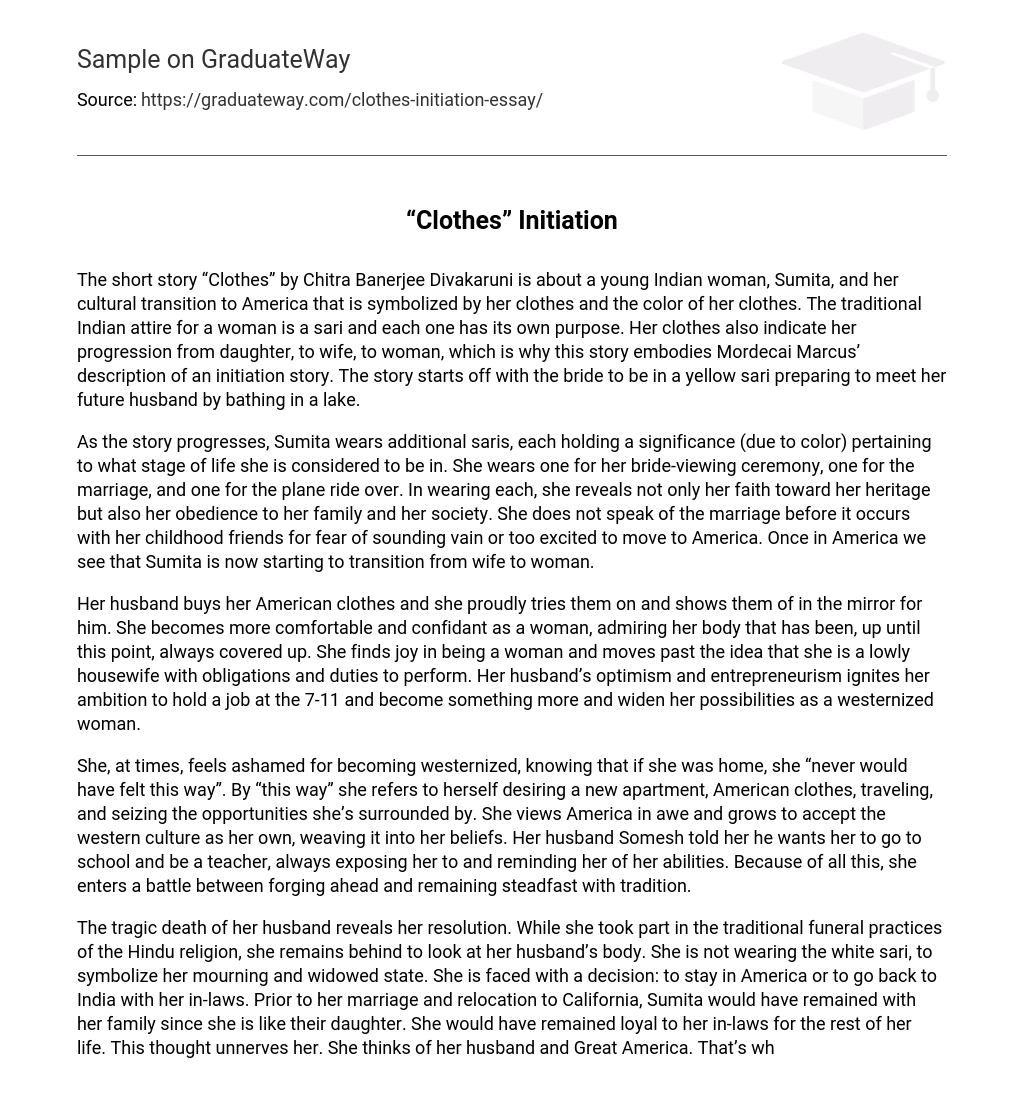In the short story “Clothes” by Chitra Banerjee Divakaruni, the protagonist Sumita, a young Indian woman, undergoes a cultural transition to America. This transition is represented through her clothing choices and their colors, as the traditional Indian attire holds special significance for women. The different saris she wears also symbolize her journey from daughterhood to wifehood and ultimately womanhood, making this story align with Mordecai Marcus’ definition of an initiation narrative. The narrative begins with Sumita, as a prospective bride, adorned in a yellow sari as she prepares to meet her future husband, engaging in a ritualistic bathing in a lake.
Throughout the narrative, Sumita dons various saris, with each carrying its own symbolic significance based on the stage of life she finds herself in. These include a sari for her bride-viewing ceremony, one for the wedding itself, and another for her journey on the plane. By wearing these saris, Sumita not only showcases her commitment to her heritage but also displays her loyalty to both her family and her society. Prior to the marriage, she refrains from discussing it with her childhood friends, fearing that she may come across as conceited or overly eager to relocate to America. Once she reaches America, we witness Sumita’s gradual shift from being a wife to an independent woman.
Her husband purchases American clothing for her, which she happily puts on and models in front of the mirror to please him. This experience helps her gain confidence and feel at ease as a woman, appreciating her previously concealed body. Discovering happiness in embracing her femininity, she overcomes the notion of being a mere housewife burdened with responsibilities and obligations. Her husband’s hopeful outlook and enterprising spirit inspire her to strive for employment at the 7-11, aiming to transcend her current role and explore a broader range of opportunities as a woman influenced by Western culture.
Occasionally, she feels ashamed for adopting western customs and realizes that if she were in her home country, these feelings would not exist. When she mentions “this way,” she is referring to her longing for a modern apartment, clothing in the American style, the chance to travel, and the ability to seize opportunities all around her. The allure of America captivates her and eventually she fully embraces western culture, incorporating it into her own beliefs. Her husband Somesh supports her pursuit of education and encourages her to become a teacher, always reminding her of her potential. Consequently, she finds herself torn between progressing forward and adhering to traditional values.
Although participating in traditional Hindu funeral practices, the widow breaks from tradition by choosing not to wear the mourning and widowhood symbolized by a white sari. Instead, she ponders whether to remain in America or return to India with her in-laws while staying beside her husband’s body. In the past, she would have stayed with her own family and remained devoted to her in-laws for life. However, reflecting on her late husband and experiences in America, she realizes going back is not an option. Despite feeling uncertain about navigating this new land, she resolves to stay here. She compares herself to Indian widows who conform to traditional roles but feel powerless. The story ends with her confronting her American-dressed in-laws and asserting her choice to stay in California. This transformation has been influenced by Western culture, introspection, and memories of her late spouse.
Marcus believes that this type of initiation story is incomplete because it guides the main character towards growth and understanding but leaves them in a state of uncertainty. Sumita realizes that she cannot reverse her decision to not return to India. Despite knowing she will be alone, she chooses to stay in America because she believes it is the optimal choice for her. As the story progresses, Sumita gains experience and maturity, which transform her greatly. She symbolically replaces her traditional sari with Western clothing like jeans and a T-shirt. She refuses to be restricted like a bird with its wings clipped.





